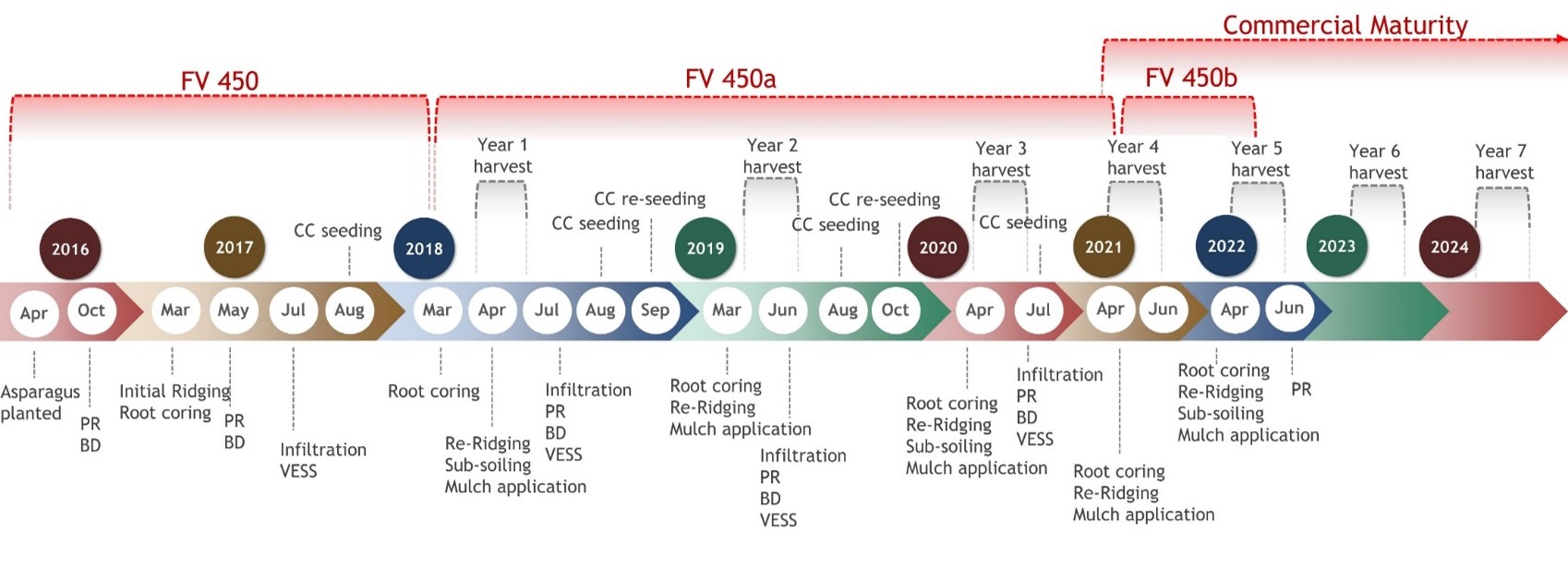Please click here to access the main AHDB website and other sectors.
- Home
- Knowledge library
- Factors affecting soil health and asparagus profitability
Factors affecting soil health and asparagus profitability
Improved asparagus yield, profitability, soil health, alleviation of soil compaction, and increased water infiltration can be achieved by making changes to conventional asparagus agronomy practice.
This information was last updated in 2023.
Go back to the main page: asparagus stand longevity and yield optimisation
The long-term AHDB project FV450/a/b field trials (Figure 1) confirmed that improved asparagus yield, profitability, soil health, alleviation of soil compaction, and increased infiltration can be achieved by moving away from conventional practice and adopting one of several alternative Best Management Practice (BMP) options.
 Dr Rob Simmons (Cranfield)
Dr Rob Simmons (Cranfield)
Figure 1. Research project FV 450/a/b timeline and activities, and period of commercial maturity.
Conventional practice is defined as asparagus grown with bare soil interrows that is ridged on an annual basis without tillage or mulches applied to interrows.
Find below the details of some BMPs which can have positive effects on both asparagus yield and stand longevity, as well as soil health.
Zero-tillage
Zero-tillage (see figure 2) also referred to as ‘ridging for life’ can result in significant yield uplift, improved yield and profitability, reduced soil compaction and improved soil health as compared with conventional practice. Between 2018-2022 Zero-tillage was associated with a 14-57% yield uplift as compared to the conventional practice.
Zero-tillage is defined as asparagus grown with bare soil interrows without any annual re-ridging applied after the first ridging event or shallow soil disturbance of interrows.
Zero tillage essentially minimises the trafficking of agricultural machinery associated with annual re-ridging or interrow tillage operations. This reduces soil compaction and increases infiltration rate reducing runoff and erosion risk as compared with the conventional practice. Zero-tillage also allows the soil microbial community to develop without disturbance from tillage operations.
Companion cropping
A companion crop is a crop grown together with the primary crop in order to gain some advantage in terms of yield, crop protection for pests and/or diseases and for environmental benefits.
Companion cropping (see figure 2) of asparagus interrows has the potential to reduce soil compaction and increase water infiltration by improving soil structure via the bio-drilling effect of roots. In addition, companion crops increase overwintered ground cover and reduce erosion risk. They also have the potential to stimulate mycorrhizal associations, supress weeds and soil pathogenic fungi through root exudates. Results from the AHDB project FV450/a/b field trials demonstrate that between 2018-2022, companion cropping with cereal rye (Secale cereale) in combination with annual re-ridging can result in significantly higher yields (16-28%) as compared with conventional practice.
However, it is important to note that non-ridging carries the risk of a 14-22% yield penalty compared with the ridged rye BMP. This suggests that growers need to be confident that they can re-ridge in the spring following broadcasting the rye the previous August for overwintered run-off and erosion control.
Interrow mulching in combination with shallow soil disturbance (SSD)
Interrow mulching post-ridging with either straw (6 t ha-1) or PAS 100 QP compliant compost (25 t ha-1) has been shown to significantly reduce soil erosion from asparagus. In addition, the combination of application of PAS 100 compost application to interrow wheelings post-ridging and shallow soil disturbance (SSD) post-harvest results in significantly (>20%) higher yields as compared with conventional practice. Shallow soil disturbance post-harvest was achieved using a winged tine operating at 0.15-0.2m depth.
Interrow mulching in combination with SSD (see figure 2) was also associated with significantly reduced compaction of interrow wheelings and up to a 200-fold increase in soil infiltration rates. This significantly reduces erosion risk. In addition, this BMP stimulated soil microbiology and earthworm activity resulting in increased soil biodiversity and abundance.
 Dr Rob Simmons (Cranfield)
Dr Rob Simmons (Cranfield)
Figure 2. Best practice management practices and conventional practice treatments investigated during the project.
Authors
Dr Rob Simmons, Dr Lucie Maskova, and Dr Lynda Deeks.
This study was funded by AHDB under projects FV 450, FV 450a and FV450b 'Sustainable soil management for stand longevity and yield optimization in asparagus', with co-funding from Cranfield University and Cobrey Farms Ltd.


Topics:
Sectors:
Tags:

